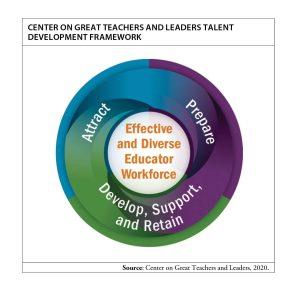FOCUS
How districts and states are addressing teacher turnover
By Lisa Lachlan-Haché, Lois Kimmel, Cheryl Krohn, Dawn Dolby and Tammie Causey-Konaté
Categories: Collaboration, Equity, System leadershipFebruary 2023
Open your morning news app, and you’ll likely find an article that suggests the teaching profession is in crisis. Headlines shout, “Never seen it this bad” (Walker, 2021). Reports highlight the status of the teaching profession is at a 50-year low, noting sobering statistics about low teacher morale, the loss of professional prestige, lack of student interest to pursue teaching, and increased percentages of teachers thinking about leaving (Marken & Agrawal, 2022; Mission Square Research Institute, 2021; Steiner & Woo, 2021).
A scan of U.S. initiatives shows we need multiple entry points and action steps for boosting teacher retention. #TheLearningPro Share on XSolutions often focus on recruiting more candidates into the profession. Although such approaches are important, another element critical to success doesn’t get enough attention: retaining the teachers serving in classrooms now. While recruitment efforts focus on building the profession over the long term, retention efforts are essential for maintaining and improving the quality of teaching today.
Our work at the Center on Great Teachers and Leaders recognizes the need for a comprehensive approach to address shortages across the talent development continuum (see figure at right): attracting students into the profession, preparing candidates to become learner-ready on day one, and developing, supporting, and retaining teachers in the profession.

In this article, we focus on the developing, supporting, and retaining teachers quadrant of the talent development framework because it is most often overlooked yet vital.
Research illustrates the detrimental effects teacher turnover has on student satisfaction and achievement (Ronfeldt et al., 2013). Evidence also suggests that teacher experience is correlated with teacher effectiveness (Kini & Podolsky, 2016). If teachers are leaving within the first three years, students are missing out on the impact of experienced teachers, and teachers miss the opportunity to improve and find success.
Furthermore, national data suggests that teachers of color leave the profession at higher rates due to more challenging working conditions, fewer supports, and systems working against them (Brown, 2022; Dixon et al., 2019; Ingersoll et al., 2017). Given that research suggests student-teacher race match has a positive impact on students of color in the short and long term (Gershenson et al., 2018), the high turnover rate of teachers of color is alarming.
The talent development framework addresses multiple dimensions of teacher retention, including high-quality mentoring, differentiated staffing models, job-embedded professional learning, financial incentives, inclusive teaching environments, responsive working conditions, and strong leadership for healthy and supportive schools and advancing equity. The examples we provide here focus on teacher development and support, with implications for professional learning leaders.
They are based on an extensive review of programs focused on educator shortages and workforce diversity conducted in 2022. These examples do not represent an exhaustive list of approaches leaders can take, but rather highlight entry points and action steps learning professionals may choose to emulate in their own contexts.
Developing beginning teachers
Many new teachers joining the profession today experienced interrupted inservice placements or truncated preservice support due to the disruptions caused by the pandemic. A lack of preparation can lead new teachers to feel overwhelmed and potentially to attrition. To address the growing need for mentoring and induction supports for new teachers, states and districts are ramping up supports with new federal funding.
For example, new teachers in Georgia receive intensive mentoring and induction support that infuse high-leverage practices with simulated classroom experience, allowing them critical opportunities to prepare to be learner-ready as they approach their first days in the classroom. The Ohio Department of Education is also focusing on mentoring and induction, with a special emphasis on supporting new teachers from underrepresented backgrounds with culturally responsive mentoring that acknowledges the unique struggles that new teachers of color experience.
Creating inclusive teaching environments
Culturally affirming and healthy workspaces enable educators to bring their authentic selves to the work of teaching and may lead to greater retention rates for teachers of color (Dixon et al., 2019). Professional learning — for example, in partnership with organizations like the Center for Black Educator Development — can help leaders and other staff do more to create such environments.
Educators at Park Spanish Immersion Elementary School in suburban Minneapolis, Minnesota, are examining their cultural competency and determining ways to make their school culture more racially and ethnically inclusive. The Supporting Inclusive and Diverse Educator Environments partnership engaged 45 members of the school’s leadership team in learning about cultural proficiency, continuous leadership coaching focused on building an inclusive school culture, affinity groups to develop teacher peer support, and mentor preparation.
Differentiating staffing structures
Arizona State University’s Mary Lou Fulton Teachers College is working closely with Mesa Public Schools to design a new model of co-teaching, building on Public Impact’s Opportunity Culture model, which has shown positive effects on collaborative professional learning, teacher satisfaction, and student learning (Backes & Hansen, 2018; Garcia et al., 2021).
The new model builds teams of educators with distributed expertise, including an education leader (who leads teams, schools, or systems), professional educators (preservice, novice, experienced, and specialist teachers), community educators (prepared members of the community), and paraeducators who complement the work of professional educators. Teams work and grow together, building on and learning from one another throughout the school day.
Early results suggest that educators participating in the model are more satisfied, collaborate more, and believe they have better teacher-student interactions (Arizona Impact, 2022; Maddin, 2023) — factors that lay the groundwork for a more stable and satisfied workforce. The project is now scaling up with funding from a Teacher and School Leader Grant provided by the U.S. Department of Education.
Building teachers’ social and emotional competencies
Teachers say they face increasing challenges with student behavior and mental health struggles and report a need for more training and strategies to deal with those challenges (Mahnken, 2023). Such feelings likely contribute to high rates of teacher burnout.
To address these challenges, districts are helping teachers develop their competencies in social and emotional learning (SEL). In J. Sterling Morton High School District 201 in Cicero, Illinois, and Pasco County Schools in Florida, teachers are growing their social and emotional competencies by embedding SEL standards into their curriculum and daily instruction to ensure SEL becomes part of teacher behavior, classroom practice, and school climate.
Instructional coaches in these districts support teachers in advancing their SEL practices through co-planning, modeling, and feedback on student engagement with SEL strategies and standards. Our center developed a self-assessment, in partnership with National University, for educators to reflect on their own social and emotional competencies and practices (Yoder, 2022).
Teachers can then engage in asynchronous online modules co-developed by Inspire: Leading in Learning and the American Institutes for Research that cover topics such as the neuroscience of emotions, self-compassion and self-regulation, teamwork, and problem-solving, among others (Inspire: Leading in Learning, n.d.).
Building leadership skills
Teachers’ experiences are influenced directly and indirectly by school and district leaders, who also have challenges and are at risk for attrition (Steiner et al., 2022). Supporting leaders to build their leadership skills benefits not just leaders themselves, but everyone in the school community.
Some school leadership preparation programs — which are sometimes designed in partnership with districts and states — are working to address the challenges facing leaders today, including high levels of student and teacher stress, student learning loss, and inequity. These efforts work best when they are designed to be systemic and program-wide.
For example, rather than having a single course on equity, culturally responsive pedagogy, or social and emotional learning, the Institute of School Leadership & Administration Faculty at Loyola Marymount University is revising the curriculum to embed these critical topics in all aspects of principal preparation, including school finance, setting instructional visions, and even setting school schedules. These leaders will be better prepared to create healthy and supportive schools where teachers are more likely to stay.
In the Educator Preparation Laboratory, Learning Policy Institute and the Bank Street Graduate School of Education are co-leading a collaboration among 15 teacher and principal preparation programs designed to develop and document models that prepare educators and leaders to advance equity and the science of learning. This work supports educators in being better prepared for their classrooms through equity-focused and responsive practices that can lead to their retention in the profession.
Looking to the future
The strategies presented here can be combined with other elements of the talent development continuum, including improving working conditions and teacher compensation. This can be a complicated undertaking, but several factors can help.
Collaboration among schools, districts, states, universities, and intermediaries is important. We promote partnerships like these in the Center on Great Teachers and Leaders National Collaboratives (Center on Great Teachers and Leaders, 2022a; Mason-Williams et al., 2020) to ensure all players who have a role in supporting teachers have a seat at the table.
Using data to drive decisions is also essential. Data tools can help, such as our center’s Diversifying the Educator Workforce Data Tool (Center on Great Teachers and Leaders, 2021) and Geographic Information System maps (Center on Great Teachers and Leaders, 2022b), which support state and local leaders to identify shortages and diversity gaps in their systems.
In our National Collaboratives, we support teams as they examine the data to look at all stages of the career development continuum. We work together to analyze disaggregated data, engage stakeholders, select actions and evidence-based strategies, and monitor and continuously revise and revamp to better prioritize areas of need based on local context.
With all of these strategies, teacher voice matters. Increasing teacher voice in school decisions not only adds important insights to the process, but can increase satisfaction, buy-in, and sense of school community (Witmer & Wimer, 2021; Sherratt et al, 2013).
In all of these efforts, we need to focus on retaining teachers of color. This is essential for addressing inequities in our systems and the needs for more culturally responsive and relevant practices.
While making strides to address the challenges the teaching profession faces takes significant effort, we see the initial steps are proceeding through promising programs and practices in states and districts across the country. News reports may never tell the full story of the success and innovation found within our classrooms, school buildings, and state houses. But the work of elevating the profession is underway now and will continue to shape our profession and the quality of our education system for years to come. Let’s recognize and champion our success by leaning into more comprehensive approaches that look to the future while also developing, supporting, and retaining the teachers in our classrooms today.
References
Arizona Impact. (2022). ASU-developed team-teaching model a hit at Valley schools. news.asu.edu/20221205-arizona-impact-asudeveloped-teamteaching-model-hit-valley-schools
Backes, B. & Hansen, M. (2018). Reaching further and learning more? Evaluating Public Impact’s Opportunity Culture Initiative. CALDER Center. caldercenter.org/publications/reaching-further-and-learning-more-evaluating-public-impacts-opportunity-culture
Brown, E. (2022). Is racial congruence between teachers and students enough? Skewed workplace compositions and early career African American teachers’ perception of institutional culture. In C.D. Gist & T.J. Bristol (Eds.), Handbook of research on teachers of color and Indigenous teachers. American Educational Research Association.
Center on Great Teachers and Leaders. (2020). Managing educator talent: A research-based framework for district and state policymakers. American Institutes for Research.
Center on Great Teachers and Leaders. (2021). Diversifying the educator workforce data tool. American Institutes for Research. gtlcenter.org/technical-assistance/insights-diversifying-educator-workforce
Center on Great Teachers and Leaders. (2022a). Strengthen and diversify the educator workforce: Address shortages by engaging stakeholders in a data-driven, equity-focused approach. American Institutes for Research.
Center on Great Teachers and Leaders. (2022b). GIS mapping to strengthen the educator workforce. American Institutes for Research. gtlcenter.org/projects/colorado-strengthening-educator-workforce-using-geographic-information-systems
Dixon, D., Griffin, A., & Teoh, M. (2019). If you listen, we will stay: Why teachers of color leave and how to disrupt teacher turnover. The Education Trust and Teach Plus.
Garcia, J., Wiseman, A.W., Kirksey, J., & Gottlieb, J. (2021, September 14). Opportunity culture update and program evaluation [Slide presentation]. BoardBook Premier.
Gershenson, S., Hart, C.M., Hyman, J., Lindsay, C., & Papageorge, N.W. (2018). The long-run impacts of same-race teachers (No. w25254). National Bureau of Economic Research.
Ingersoll, R., May, H., & Collins, G. (2017). Minority teacher recruitment, employment, and retention: 1987 to 2013 [Research brief]. Learning Policy Institute.
Inspire: Leading in Learning (n.d.). What is educator SEL? www.inspiresel.org/educator-sel/
Kini, T. & Podolsky, A. (2016). Does teaching experience increase teacher effectiveness? A review of the research. Learning Policy Institute.
Maddin, B. (2023). Building the next generation workforce. How a district-university parnetship is transforming both institutions. A presentation at the American Association for School Personnel Administrators, January 2023.
Mahnken, K. (2023, January 12). New data: Post-COVID, school leaders frustrated in efforts to curb misbehavior. The 74. www.the74million.org/article/new-federal-data-show-schools-limited-in-addressing-misbehavior/
Marken, S. & Agrawal, S. (2022). K-12 workers have highest burnout rate in U.S. Gallup News. news.gallup.com/poll/393500/workers-highest-burnout-rate.aspx
Mason-Williams, L., Rosenberg, M., Kimmel, L., & Sindelar, P. (2020). Addressing shortages of educators in an uncertain COVID-19 landscape: Viewing teacher candidates as assets. CEEDAR Center, AACTE, & Center on Great Teachers and Leaders.
Mission Square Research Institute. (2021, September). 2021 updated survey results: K-12 public school employee views on finances, employment outlook, and safety concerns due to COVID-19. Author.
Ronfeldt, M., Loeb, S., & Wyckoff, J. (2013). How teacher turnover harms student achievement. American Educational Research Journal, 50(1), 4-36.
Sherratt, E., Rizzolo, A., Laine, S., & Friedman, W. (2013). Everyone at the table: Engaging teachers in evaluation reform. Jossey Bass.
Steiner, E.D. & Woo, A. (2021). Job-related stress threatens the teacher supply: Key findings from the 2021 State of the U.S. Teacher Survey. RAND Corporation.
Steiner, E.D., Doan, S., Woo, A., Gittens, A.D., Lawrence, R.A., Berdie, L., Wolfe, R. L., Greer, L., & Schwartz, H.L. (2022). Restoring teacher and principal well-being is an easy step for rebuilding schools: Findings from the State of the American Teacher and the American Principal surveys. RAND Corporation.
Walker, T. (2021, November 12). Getting serious about teacher burnout. NEA News. www.nea.org/advocating-for-change/new-from-nea/getting-serious-about-teacher-burnout
Witmer, M.M.G. & Wimer, J.W. (2021). Expressions of authentic voice: Urban high school students’ perceptions of teaching as a career choice while participating in a pipeline program for aspiring teachers of color. Education and Urban Society, 54(8), 969-991.
Yoder, N. (2022, December 1). Self-assessing social and emotional instruction and competencies: A tool for teachers. American Institutes for Research. www.air.org/resource/self-assessing-social-and-emotional-instruction-and-competencies-tool-teachers
Categories: Collaboration, Equity, System leadership
Recent Issues
WHERE TECHNOLOGY CAN TAKE US
April 2024
Technology is both a topic and a tool for professional learning. This...
EVALUATING PROFESSIONAL LEARNING
February 2024
How do you know your professional learning is working? This issue digs...
TAKING THE NEXT STEP
December 2023
Professional learning can open up new roles and challenges and help...
REACHING ALL LEARNERS
October 2023
Both special education and general education teachers need support to help...














